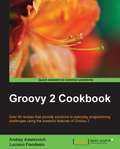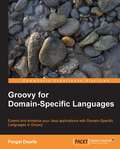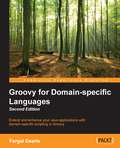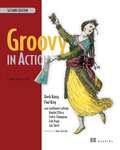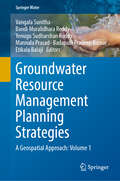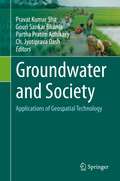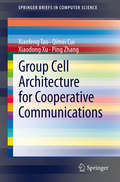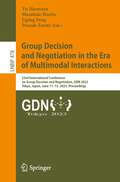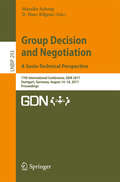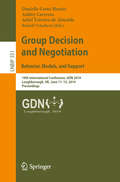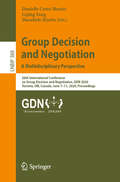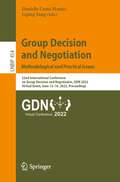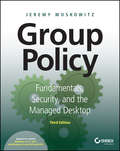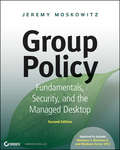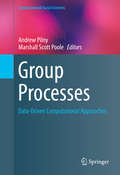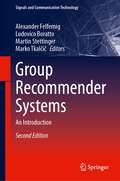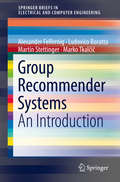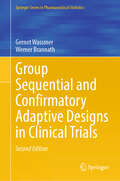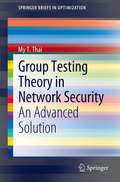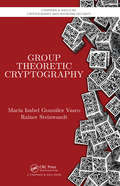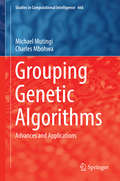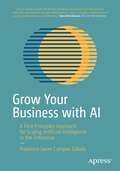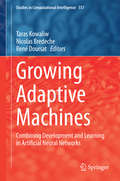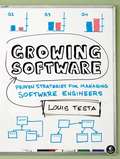- Table View
- List View
Groovy 2 Cookbook
by Andrey Adamovich Luciano FiandesioThis book follows a Cookbook style and is packed with intermediate and advanced level recipes.This book is for Java developers who have an interest in discovering new ways to quickly get the job done using a new language that shares many similarities with Java. The book's recipes start simple, therefore no previous Groovy experience is required to understand the code and the explanations accompanying the examples.
Groovy for Domain-Specific Languages
by Fergal DearleThis book is a practical tutorial, walking the reader through examples of building DSLs with Groovy covering meta-programming with Groovy. Some complex concepts are covered in the book but we go through these in a clear and methodically way so that readers will gain a good working knowledge of the techniques involved. This book is for Java software developers who have an interest in building domain scripting into their Java applications. No knowledge of Groovy is required, although it will be helpful. The book does not teach Groovy, but quickly introduces the basic ideas of Groovy. An experienced Java developer should have no problems with these and move quickly on to the more involved aspects of creating DSLs with Groovy. No experience of creating a DSL is required. The book should also be useful for experienced Groovy developers who have so far only used Groovy DSLs such as Groovy builders and would like to start building their own Groovy-based DSLs.
Groovy for Domain-specific Languages - Second Edition
by Fergal DearleExtend and enhance your Java applications with domain-specific scripting in Groovy About This Book * Build domain-specific mini languages in Groovy that integrate seamlessly with your Java apps with this hands-on guide * Increase stakeholder participation in the development process with domain-specific scripting in Groovy * Get up to speed with the newest features in Groovy using this second edition and integrate Groovy-based DSLs into your existing Java applications. Who This Book Is For This book is for Java software developers who have an interest in building domain scripting into their Java applications. No knowledge of Groovy is required, although it will be helpful. This book does not teach Groovy, but quickly introduces the basic ideas of Groovy. An experienced Java developer should have no problems with these and move quickly on to the more involved aspects of creating DSLs with Groovy. No experience of creating a DSL is required. What You Will Learn * Familiarize yourself with Groovy scripting and work with Groovy closures * Use the meta-programming features in Groovy to build mini languages * Employ Groovy mark-up and builders to simplify application development * Familiarize yourself with Groovy mark-up and build your own Groovy builders * Build effective DSLs with operator overloading, command chains, builders, and a host of other Groovy language features * Integrate Groovy with your Java and JVM based applications In Detail The times when developing on the JVM meant you were a Java programmer have long passed. The JVM is now firmly established as a polyglot development environment with many projects opting for alternative development languages to Java such as Groovy, Scala, Clojure, and JRuby. In this pantheon of development languages, Groovy stands out for its excellent DSL enabling features which allows it to be manipulated to produce mini languages that are tailored to a project's needs. A comprehensive tutorial on designing and developing mini Groovy based Domain Specific Languages, this book will guide you through the development of several mini DSLs that will help you gain all the skills needed to develop your own Groovy based DSLs with confidence and ease. Starting with the bare basics, this book will focus on how Groovy can be used to construct domain specific mini languages, and will go through the more complex meta-programming features of Groovy, including using the Abstract Syntax Tree (AST). Practical examples are used throughout this book to de-mystify these seemingly complex language features and to show how they can be used to create simple and elegant DSLs. Packed with examples, including several fully worked DSLs, this book will serve as a springboard for developing your own DSLs. Style and approach This book is a hands-on guide that will walk you through examples for building DSLs with Groovy rather than just talking about "metaprogramming with Groovy". The examples in this book have been designed to help you gain a good working knowledge of the techniques involved and apply these to producing your own Groovy based DSLs.
Groovy in Action
by Paul King Cédric Champeau Dierk Koenig Hamlet D'ArcySummaryGroovy in Action, Second Edition is a thoroughly revised, comprehensive guide to Groovy programming. It introduces Java developers to the dynamic features that Groovy provides, and shows how to apply Groovy to a range of tasks including building new apps, integration with existing code, and DSL development. Covers Groovy 2.4.Purchase of the print book includes a free eBook in PDF, Kindle, and ePub formats from Manning Publications.About the TechnologyIn the last ten years, Groovy has become an integral part of a Java developer's toolbox. Its comfortable, common-sense design, seamless integration with Java, and rich ecosystem that includes the Grails web framework, the Gradle build system, and Spock testing platform have created a large Groovy communityAbout the BookGroovy in Action, Second Edition is the undisputed definitive reference on the Groovy language. Written by core members of the Groovy language team, this book presents Groovy like no other can—from the inside out. With relevant examples, careful explanations of Groovy's key concepts and features, and insightful coverage of how to use Groovy in-production tasks, including building new applications, integration with existing code, and DSL development, this is the only book you'll need. Updated for Groovy 2.4.Some experience with Java or another programming language is helpful. No Groovy experience is assumed.What's InsideComprehensive coverage of Groovy 2.4 including language features, libraries, and AST transformationsDynamic, static, and extensible typingConcurrency: actors, data parallelism, and dataflowApplying Groovy: Java integration, XML, SQL, testing, and domain-specific language supportHundreds of reusable examplesAbout the AuthorsAuthors Dierk König, Paul King, Guillaume Laforge, Hamlet D'Arcy, Cédric Champeau, Erik Pragt, and Jon Skeet are intimately involved in the creation and ongoing development of the Groovy language and its ecosystem.Table of ContentsPART 1 THE GROOVY LANGUAGEYour way to GroovyOverture: Groovy basicsSimple Groovy datatypesCollective Groovy datatypesWorking with closuresGroovy control structuresObject orientation, Groovy styleDynamic programming with GroovyCompile-time metaprogramming and AST transformationsGroovy as a static languagePART 2 AROUND THE GROOVY LIBRARYWorking with buildersWorking with the GDKDatabase programming with GroovyWorking with XML and JSONInteracting with Web ServicesIntegrating GroovyPART 3 APPLIED GROOVYUnit testing with GroovyConcurrent Groovy with GParsDomain-specific languagesThe Groovy ecosystem
Groundwater Resource Management Planning Strategies: A Geospatial Approach: Volume 1 (Springer Water)
by Etikala Balaji Vangala Sunitha Bandi Muralidhara Reddy Yenugu Sudharshan Reddy Mannala Prasad Badapalli Pradeep KumarGeospatial tools to Groundwater Resources explain the most recent methods in Geographic Information Systems (GIS) and geostatistics as they apply to groundwater through complete case studies that demonstrate actual remote sensing applications in this field. Due to the rising demand for water, its decreasing quality, and its limited supply, water resource management has grown to be a serious issue. In many places of the world, groundwater is the main supply of fresh water, but certain areas are growing unduly reliant on it, utilising groundwater more quickly than it can be replenished naturally and resulting in an unceasing decrease in water tables. For the efficient use, management, and modelling of this priceless but diminishing natural resource, systematic planning of groundwater consumption using current approaches is crucial. Remote sensing, GIS, GPS (Global Positioning Systems), and geostatistical approaches are among the effective water management methods that have developed with the introduction of powerful and fast personal computers. Now more than ever, it is possible to analyse with greater accuracy the relationships between environmental elements and human health and wellbeing. Our understanding of the continuum between environment and health consequences on many different sizes, from the global to even the individual, has evolved thanks to a number of transdisciplinary accomplishments. This book covers a wide range of geospatial health-related topics and methods, including climate change, healthcare utilisation, health disparities, air quality assessment, asthma, water quality assessment, and machine learning. It also advances scientific understanding, development, and application of geospatial technologies related to water resource management. Researchers and postgraduate students in Earth and Environmental Sciences, particularly GIS, agriculture, hydrology, natural resources, and soil science, who need to be ableto apply the most recent innovations in groundwater research in a practical way will find Case Studies in Geospatial Applications to Groundwater Resources to be a valuable resource. This edited volume will concentrate on the most recent studies and uses of geospatial methods in water resource management, offering insights into the difficulties and possibilities of applying these methods to solve practical issues.
Groundwater and Society: Applications of Geospatial Technology
by Gouri Sankar Bhunia Pravat Kumar Shit Partha Pratim Adhikary Ch. Jyotiprava DashThis volume advances the scientific understanding, development, and application of geospatial technologies related to groundwater resource management, mapping, monitoring, and modelling using up-to-date remote sensing and GIS techniques. The book further provides a critical analysis of the debates and discourses surrounding groundwater resources and society, illustrates the relationship between groundwater resources and precision agriculture for societal development, and describes novel, region-specific management strategies and techniques for sustainability with case studies. The book is organized into three parts: (I) Groundwater resources and societal development; (II) Groundwater availability, quality and pollution; and (III) Sustainable groundwater resources management. Each section begins with a short introduction that includes an overview of the papers in that section. Individual chapters focus on the core themes of research and knowledge along with some topics that have received lesser attention. The book will be of interest to water resource planners and decision-makers, academic researchers, policy makers, NGOs, and academic researchers and students in Geography, Geophysics, Hydrology, Remote Sensing & GIS, Agriculture, Soil Science, and Agronomy.
Group Cell Architecture for Cooperative Communications
by Ping Zhang Qimei Cui Xiaodong Xu Xiaofeng TaoDriven by the increasing demand for capacity and Quality of Service in wireless cellular networks and motivated by the distributed antenna system, the authors proposed a cooperative communication architecture--Group Cell architecture, which was initially brought forward in 2001. Years later, Coordinated Multiple-Point Transmission and Reception (CoMP) for LTE-Advanced was put forward in April 2008, as a tool to improve the coverage of cells having high data rates, the cell-edge throughput and/or to increase system throughput. This book mainly focuses on the Group Cell architecture with multi-cell generalized coordination, Contrast Analysis between Group Cell architecture and CoMP, Capacity Analysis, Slide Handover Strategy, Power Allocation schemes of Group Cell architecture to mitigate the inter-cell interference and maximize system capacity and the trial network implementation and performance evaluations of Group Cell architecture.
Group Decision and Negotiation in an Uncertain World: 18th International Conference, GDN 2018, Nanjing, China, June 9-13, 2018, Proceedings (Lecture Notes in Business Information Processing #315)
by Rudolf Vetschera Haiyan Xu Ye Chen Gregory KerstenThis book constitutes the refereed proceedings of the 18th International Conference on Group Decision and Negotiation, GDN 2018, held in Nanjing, China, in June 2018. The field of Group Decision and Negotiation focuses on decision processes with at least two participants and a common goal but conflicting individual goals. Research areas of Group Decision and Negotiation include electronic negotiations, experiments, the role of emotions in group decision and negotiations, preference elicitation and decision support for group decisions and negotiations, and conflict resolution principles.The 15 full papers presented in this volume were carefully reviewed and selected from 143 submissions. They were organized in topical sections named: theoretical concepts of group decision and negotiation; decision support and behavior in group decision and negotiation; and applications of group decision and negotiations.
Group Decision and Negotiation in the Era of Multimodal Interactions: 23rd International Conference on Group Decision and Negotiation, GDN 2023, Tokyo, Japan, June 11–15, 2023, Proceedings (Lecture Notes in Business Information Processing #478)
by Pascale Zaraté Liping Fang Masahide Horita Yu MaemuraThis book constitutes the refereed proceedings of the 23rd International Conference on Group Decision and Negotiation, GDN 2023, which took place in Tokyo, Japan during June 11–15, 2023.The field of Group Decision and Negotiation focuses on decision processes with at least two participants and a common goal but conflicting individual goals. Research areas of Group Decision and Negotiation include electronic negotiations, experiments, the role of emotions in group decision and negotiations, preference elicitation and decision support for group decisions and negotiations, and conflict resolution principles. This year’s conference focusses on multimodal interactions. The 11 full papers presented in this volume were carefully reviewed and selected from 102 submissions. They were organized in the following topical sections: Taking a step back: Critically re-examining technology interactions with group decision and negotiation; preference modeling and multi-criteria decision-making; and conflict modeling and distributive mechanisms.
Group Decision and Negotiation. A Socio-Technical Perspective: 17th International Conference, GDN 2017, Stuttgart, Germany, August 14-18, 2017, Proceedings (Lecture Notes in Business Information Processing #293)
by D. Marc Kilgour Mareike SchoopThis book constitutes the refereed proceedings of the 17th International Conference on Group Decision and Negotiation, GDN 2017, held in Stuttgart, Germany, in August 2017. The field of Group Decision and Negotiation focuses on decision processes with at least two participants and a common goal but conflicting individual goals. Research areas of Group Decision and Negotiation include electronic negotiations, experiments, the role of emotions in group decision and negotiations, preference elicitation and decision support for group decisions and negotiations, and conflict resolution principles.The 14 full papers presented in this volume were carefully reviewed and selected from 87 submissions. They were organized in topical sections named: general topics in group decision and negotiation; conflict resolution; emotions in group decision and negotiation; negotiation support systems and studies; and preference modeling for group decision and negotiation. The book also contains two invited talks in full paper length.
Group Decision and Negotiation: 19th International Conference, GDN 2019, Loughborough, UK, June 11–15, 2019, Proceedings (Lecture Notes in Business Information Processing #351)
by Adiel Teixeira de Almeida Rudolf Vetschera Danielle Costa Morais Ashley CarrerasThis book constitutes the refereed proceedings of the 19th International Conference on Group Decision and Negotiation, GDN 2019, held in Loughborough, UK, in June 2019. The field of Group Decision and Negotiation focuses on decision processes with at least two participants and a common goal but conflicting individual goals. Research areas of Group Decision and Negotiation include electronic negotiations, experiments, the role of emotions in group decision and negotiations, preference elicitation and decision support for group decisions and negotiations, and conflict resolution principles. The 17 full papers presented in this volume were carefully reviewed and selected from 98 submissions. They were organized in topical sections named: preference modeling for group decision and negotiations; collaborative decision making processes; conflict resolution; behavioral OR, and negotiation support systems and studies.
Group Decision and Negotiation: 20th International Conference on Group Decision and Negotiation, GDN 2020, Toronto, ON, Canada, June 7–11, 2020, Proceedings (Lecture Notes in Business Information Processing #388)
by Liping Fang Danielle Costa Morais Masahide HoritaThis book constitutes the refereed proceedings of the 20th International Conference on Group Decision and Negotiation, GDN 2020, which was planned to be held in Toronto, ON, Canada, during June 7–11, 2020. The conference was cancelled due to the Coronavirus pandemic. Nevertheless, it was decided to publish the proceedings, because the review process had already been completed at the time the cancellation was decided. The field of Group Decision and Negotiation focuses on decision processes with at least two participants and a common goal but conflicting individual goals. Research areas of Group Decision and Negotiation include electronic negotiations, experiments, the role of emotions in group decision and negotiations, preference elicitation and decision support for group decisions and negotiations, and conflict resolution principles. The 14 full papers presented in this volume were carefully reviewed and selected from 75 submissions. They were organized in topical sections named: Conflict Resolution, Preference Modeling for Group Decision and Negotiation, Intelligent Group Decision Making and Consensus Process, Collaborative Decision Making Processes.
Group Decision and Negotiation: 22nd International Conference on Group Decision and Negotiation, GDN 2022, Virtual Event, June 12–16, 2022, Proceedings (Lecture Notes in Business Information Processing #454)
by Liping Fang Danielle Costa MoraisThis book constitutes the refereed proceedings of the 22nd International Conference on Group Decision and Negotiation, GDN 2022, which was held virtually during June 12–16, 2022. The field of Group Decision and Negotiation focuses on decision processes with at least two participants and a common goal but conflicting individual goals. Research areas of Group Decision and Negotiation include electronic negotiations, experiments, the role of emotions in group decision and negotiations, preference elicitation and decision support for group decisions and negotiations, and conflict resolution principles. This year’s conference focusses on methodological and practical issues. The 9 full papers presented in this volume were carefully reviewed and selected from 68 submissions. They were organized in the following topical sections: Preference modeling for group decision and negotiation; conflict resolution; collaborative decision making processes.
Group Policy
by Jeremy MoskowitzThe Ultimate Book on Group Policy Freshly updated to include Windows 7, Windows 8 and Windows Server 2012, Group Policy: Fundamentals, Security, and the Managed Desktop, Second Edition is the book for learning everything you need to know about Group Policy, no matter which version of Windows you use. Microsoft Group Policy MVP Jeremy Moskowitz covers it all--major Group Policy categories, what Windows 8 and Windows Server 2012 bring to the table, and smart ways to tackle tough desktop management problems. Topics include troubleshooting, security, scripting, using Windows PowerShell when necessary, and much more. Inside this book, you'll learn to: Master all Group Policy functions of Windows, including Windows XP through Windows 8 and Windows Server 2003 through Windows Server 2012 Enhance your Group Policy reach with the Group Policy Preferences, ADMX files, and additional add-ons Use every feature of the GPMC and become a top-notch administrator Troubleshoot Group Policy using tools, logs, Resource Kit utilities, Registry hacks, and third-party tools Manage printers, restrict hardware, and configure Internet Explorer Deploy software to your desktops, set up roaming profiles, and configure Offline Files for all your Windows clients--and manage it all with Group Policy settings Secure your desktops and servers with AppLocker, Windows Firewall with Advanced Security, and the Security Configuration Manager Download bonus chapters and: Script complex GPMC operations with PowerShell, including linking, backup, restore, permissions changes, and more Create a "change management" system with Advanced Group Policy Management (AGPM v4) Understand Windows Intune service and its relationship to Group Policy Coverage Includes: Updated GPMC New Windows 8 GPMC Features ADMX/ADML Files Group Policy Preferences Item-Level Targeting The Central Store AppLocker Fine-Grained Password Policy Offline Files Updates Inheritance Blocking Prioritization Linking Loopback Policy Processing Security Policy Processing Enforcing WMI Filters Third-Party Tools Cross-Forest Trusts Filters Commenting Searching Advanced Logging and Troubleshooting Advanced Auditing Controls Group Policy and VDI Security Configuration Manager Windows Intune
Group Policy: Fundamentals, Security, and the Managed Desktop
by Jeremy MoskowitzThe Ultimate Book on Group Policy Freshly updated to include Windows 7, Windows 8 and Windows Server 2012, Group Policy: Fundamentals, Security, and the Managed Desktop, Second Edition is the book for learning everything you need to know about Group Policy, no matter which version of Windows you use. Microsoft Group Policy MVP Jeremy Moskowitz covers it all—major Group Policy categories, what Windows 8 and Windows Server 2012 bring to the table, and smart ways to tackle tough desktop management problems. Topics include troubleshooting, security, scripting, using Windows PowerShell when necessary, and much more. Inside this book, you'll learn to: Master all Group Policy functions of Windows, including Windows XP through Windows 8 and Windows Server 2003 through Windows Server 2012 Enhance your Group Policy reach with the Group Policy Preferences, ADMX files, and additional add-ons Use every feature of the GPMC and become a top-notch administrator Troubleshoot Group Policy using tools, logs, Resource Kit utilities, Registry hacks, and third-party tools Manage printers, restrict hardware, and configure Internet Explorer Deploy software to your desktops, set up roaming profiles, and configure Offline Files for all your Windows clients—and manage it all with Group Policy settings Secure your desktops and servers with AppLocker, Windows Firewall with Advanced Security, and the Security Configuration Manager Download bonus chapters and: Script complex GPMC operations with PowerShell, including linking, backup, restore, permissions changes, and more Create a "change management" system with Advanced Group Policy Management (AGPM v4) Understand Windows Intune service and its relationship to Group Policy Coverage Includes: Updated GPMC New Windows 8 GPMC Features ADMX/ADML Files Group Policy Preferences Item-Level Targeting The Central Store AppLocker Fine-Grained Password Policy Offline Files Updates Inheritance Blocking Prioritization Linking Loopback Policy Processing Security Policy Processing Enforcing WMI Filters Third-Party Tools Cross-Forest Trusts Filters Commenting Searching Advanced Logging and Troubleshooting Advanced Auditing Controls Group Policy and VDI Security Configuration Manager Windows Intune
Group Processes
by Marshall Scott Poole Andrew PilnyThis volume introduces a series of different data-driven computational methods for analyzing group processes through didactic and tutorial-based examples. Group processes are of central importance to many sectors of society, including government, the military, health care, and corporations. Computational methods are better suited to handle (potentially huge) group process data than traditional methodologies because of their more flexible assumptions and capability to handle real-time trace data. Indeed, the use of methods under the name of computational social science have exploded over the years. However, attention has been focused on original research rather than pedagogy, leaving those interested in obtaining computational skills lacking a much needed resource. Although the methods here can be applied to wider areas of social science, they are specifically tailored to group process research. A number of data-driven methods adapted to group process research are demonstrated in this current volume. These include text mining, relational event modeling, social simulation, machine learning, social sequence analysis, and response surface analysis. In order to take advantage of these new opportunities, this book provides clear examples (e. g. , providing code) of group processes in various contexts, setting guidelines and best practices for future work to build upon. This volume will be of great benefit to those willing to learn computational methods. These include academics like graduate students and faculty, multidisciplinary professionals and researchers working on organization and management science, and consultants for various types of organizations and groups.
Group Recommender Systems: An Introduction (Signals and Communication Technology)
by Alexander Felfernig Marko Tkalčič Ludovico Boratto Martin StettingerThis book discusses different aspects of group recommender systems, which are systems that help to identify recommendations for groups instead of single users. In this context, the authors present different related techniques and applications. The book includes in-depth summaries of group recommendation algorithms, related industrial applications, different aspects of preference construction and explanations, user interface aspects of group recommender systems, and related psychological aspects that play a crucial role in group decision scenarios.
Group Recommender Systems: An Introduction (Springerbriefs In Electrical And Computer Engineering)
by Alexander Felfernig Marko Tkalčič Ludovico Boratto Martin StettingerThis book presents group recommender systems, which focus on the determination of recommendations for groups of users. The authors summarize different technologies and applications of group recommender systems. They include an in-depth discussion of state-of-the-art algorithms, an overview of industrial applications, an inclusion of the aspects of decision biases in groups, and corresponding de-biasing approaches. The book includes a discussion of basic group recommendation methods, aspects of human decision making in groups, and related applications. A discussion of open research issues is included to inspire new related research. The book serves as a reference for researchers and practitioners working on group recommendation related topics.
Group Sequential and Confirmatory Adaptive Designs in Clinical Trials (Springer Series in Pharmaceutical Statistics)
by Gernot Wassmer Werner BrannathThis book provides an up-to-date review of the general principles and techniques of confirmatory adaptive designs, a generalization of group sequential designs. With these designs, interim analyses are performed in order to stop a trial prematurely under control of the Type I error rate. In adaptive designs, it is also permissible to perform a data-driven change of relevant aspects of the study design at interim stages. This includes, for example, a sample-size reassessment, a treatment-arm selection, or a selection of a pre-specified sub-population.First introduced in the 1990s, this popular adaptive methodology has become the focus of intense discussion and is still a rapidly growing field of statistical research. The book describes adaptive design methodology at an elementary level, while also considering design and planning issues. It also looks at methods for analyzing an adaptively planned trial, such as estimation methods and methods for determining an overall p-value. Part I provides the group sequential preliminaries required to understand and apply the adaptive design methodology supplied in Parts II and III. Many examples are included that illustrate the practical applications of the techniques. An overview of recent developments is given and, new to this edition, detailed descriptions of the R commands used for the calculations are provided. The R package rpact, which is available on CRAN, allows for the recalculation of most tables and results presented in the monograph. The required knowledge of R has been kept to a minimum, and an online Shiny app has been made available for rpact. Primarily written for applied statisticians from academia and industry who are interested in confirmatory adaptive designs, the text is also suitable for an advanced statistical course for applied statisticians or clinicians with a sound statistical background.
Group Testing Theory in Network Security
by My T. ThaiGroup Testing Theory in Network Security explores a new branch of group testing theory with an application which enhances research results in network security. This brief presents new solutions on several advanced network security problems and mathematical frameworks based on the group testing theory, specifically denial-of-service and jamming attacks. A new application of group testing, illustrated in this text, requires additional theories, such as size constraint group testing and connected group testing. Included in this text is a chapter devoted to discussing open problems and suggesting new solutions for various network security problems. This text also exemplifies the connection between mathematical approaches and practical applications to group testing theory in network security. This work will appeal to a multidisciplinary audience with interests in computer communication networks, optimization, and engineering.
Group Theoretic Cryptography (Chapman & Hall/CRC Cryptography and Network Security Series)
by Maria Isabel Gonzalez Vasco Rainer SteinwandtGroup theory appears to be a promising source of hard computational problems for deploying new cryptographic constructions. This reference focuses on the specifics of using groups, including in particular non-Abelian groups, in the field of cryptography. It provides an introduction to cryptography with emphasis on the group theoretic perspective, making it one of the first books to use this approach. The authors provide the needed cryptographic and group theoretic concepts, full proofs of essential theorems, and formal security evaluations of the cryptographic schemes presented. They also provide references for further reading and exercises at the end of each chapter.
Grouping Genetic Algorithms
by Charles Mbohwa Michael MutingiThis book presents advances and innovations in grouping genetic algorithms, enriched with new and unique heuristic optimization techniques. These algorithms are specially designed for solving industrial grouping problems where system entities are to be partitioned or clustered into efficient groups according to a set of guiding decision criteria. Examples of such problems are: vehicle routing problems, team formation problems, timetabling problems, assembly line balancing, group maintenance planning, modular design, and task assignment. A wide range of industrial grouping problems, drawn from diverse fields such as logistics, supply chain management, project management, manufacturing systems, engineering design and healthcare, are presented. Typical complex industrial grouping problems, with multiple decision criteria and constraints, are clearly described using illustrative diagrams and formulations. The problems are mapped into a common group structure that can conveniently be used as an input scheme to specific variants of grouping genetic algorithms. Unique heuristic grouping techniques are developed to handle grouping problems efficiently and effectively. Illustrative examples and computational results are presented in tables and graphs to demonstrate the efficiency and effectiveness of the algorithms. Researchers, decision analysts, software developers, and graduate students from various disciplines will find this in-depth reader-friendly exposition of advances and applications of grouping genetic algorithms an interesting, informative and valuable resource.
Grow Your Business with AI: A First Principles Approach for Scaling Artificial Intelligence in the Enterprise
by Francisco Javier Campos ZabalaLeverage the power of Artificial Intelligence (AI) to drive the growth and success of your organization. This book thoroughly explores the reasons why it is so hard to implement AI, and highlights the need to reconcile the motivations and goals of two very different groups of people, business-minded and technical-minded. Divided into four main parts (First Principles, The Why, The What, The How), you'll review case studies and examples from companies that have successfully implemented AI. Part 1 provides a comprehensive overview of the First Principles approach and its basic conventions. Part 2 provides an in-depth look at the current state of AI and why it is increasingly important to businesses of all sizes. Part 3 delves into the key concepts and technologies of AI. Part 4 shares practical guidance and actionable steps for businesses looking to implement AI. Grow Your Business with AI is a must-read for anyone looking to understand and harness the power of AI for business growth and to stay ahead of the curve. What You'll LearnReview the key concepts and technologies of AI, including machine learning, natural language processing, and computer visionApply the benefits of AI, including increased efficiency, improved decision-making, and new revenue streams in different industriesIntegrate AI into existing systems and processes.Who This Book Is ForEntrepreneurs, business leaders, and professionals looking to leverage the power of AI to drive growth and success for their organizations.
Growing Adaptive Machines
by Taras Kowaliw Nicolas Bredeche René DoursatThe pursuit of artificial intelligence has been a highly active domain of research for decades, yielding exciting scientific insights and productive new technologies. In terms of generating intelligence, however, this pursuit has yielded only limited success. This book explores the hypothesis that adaptive growth is a means of moving forward. By emulating the biological process of development, we can incorporate desirable characteristics of natural neural systems into engineered designs and thus move closer towards the creation of brain-like systems. The particular focus is on how to design artificial neural networks for engineering tasks. The book consists of contributions from 18 researchers, ranging from detailed reviews of recent domains by senior scientists, to exciting new contributions representing the state of the art in machine learning research. The book begins with broad overviews of artificial neurogenesis and bio-inspired machine learning, suitable both as an introduction to the domains and as a reference for experts. Several contributions provide perspectives and future hypotheses on recent highly successful trains of research, including deep learning, the Hyper NEAT model of developmental neural network design, and a simulation of the visual cortex. Other contributions cover recent advances in the design of bio-inspired artificial neural networks, including the creation of machines for classification, the behavioural control of virtual agents, the desi gn of virtual multi-component robots and morphologies and the creation of flexible intelligence. Throughout, the contributors share their vast expertise on the means and benefits of creating brain-like machines. This book is appropriate for advanced students and practitioners of artificial intelligence and machine learning.
Growing Software: Proven Strategies for Managing Software Engineers
by Louis Testa<P>As the technology leader at a small software company, you need to focus on people, products, processes, and technology as you bring your software to market, while doing your best to put out fires and minimize headaches. <P>Growing Software is your guide to juggling the day-to-day challenges of running a software company while managing those long-term problems and making sure that your business continues to grow. With practical, hands-on advice, Growing Software will teach you how to build and lead an effective team, define and sell your products, work with everyone from customers to CEOs, and ensure high-quality results.Instead of learning by trial and error, you'll benefit from author Louis Testa's 20+ years of management experience. Testa combines big-picture advice, specific solutions, and real-life anecdotes to teach you how to: <br>–Work effectively with your CEO and executive team <br>–Improve development team efficiency and enthusiasm <br>–Evaluate your software methodology to improve effectiveness and safeguard against failure <br>–Use product prototypes to bridge the gap between marketing and engineering <br>–Defuse technology time bombs <P>Whether you're new to managing software or newly lost, Growing Software will help you and your growing company thrive.
